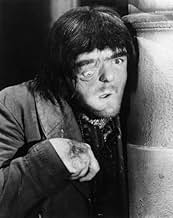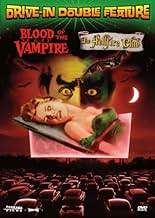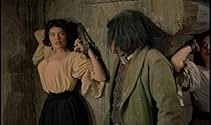Agrega una trama en tu idiomaIn 1870s Transylvania, scientist Dr. Callistratus is put to death by villagers who wrongly believe he's a vampire. However, his horribly disfigured henchman, Carl is on hand to orchestrate a... Leer todoIn 1870s Transylvania, scientist Dr. Callistratus is put to death by villagers who wrongly believe he's a vampire. However, his horribly disfigured henchman, Carl is on hand to orchestrate a life-saving heart transplant.In 1870s Transylvania, scientist Dr. Callistratus is put to death by villagers who wrongly believe he's a vampire. However, his horribly disfigured henchman, Carl is on hand to orchestrate a life-saving heart transplant.
- Auron
- (as Bryan Coleman/Brian Coleman)
- Third Guard
- (as Bruce Whiteman)
- Professor Meinster
- (as Henry Vidon)
Opiniones destacadas
The movie starts with the Count being staked through the heart and buried, before his servant 'Karl' (who plays a good Igor like character) takes his masters body to a mental asylum to revive him.
After a Doctor is wrongly accused in court of killing a patient through blood transfusing, he is sent to the asylum for his life-long punishment, only to become a servant to the Count, who wants to use his expertise in surgical practise on other inmates, mainly their blood.
This movie has the imagery of Hammer Horror, given by it's writer Jimmy Sangster, but sadly lacks the punch of a good dramatic Vampire story.
As classic Gothic horrors go, it's worth a look.
The film (which I had been looking forward to for ages after viewing stills from it in critiques of the genre penned by film historian Alan Frank) is a lurid melodrama in vivid color and with, pardon the pun, full-blooded performances but the contrived end result somehow misses the mark. For starters, the script seems uncertain whether it wants to be a Dracula (given its title and 'bloodthirsty' villain) or a Frankenstein (in view of the villain's guinea-pig experimentations with moribund or dead subjects) clone; the fact that it is almost entirely set in a mental institution-cum-prison (that includes future "Carry On" member Bernard Bresslaw as a rowdy jailbird) brings forth comparisons with the superior final Hammer Frankenstein entry FRANKENSTEIN AND THE MONSTER FROM HELL (1974)!
Distinguished thespian Donald Wolfit is surprisingly but effectively cast in the lead, while Victor Maddern has a memorable look as his knife-wielding henchman (although, again, bearing hideous features that are never explained); future Hammer startlet Barbara Shelley and Vincent Ball (playing a character saddled with the amusing name of John Pierre!), then, are reasonably appealing as the romantic leads. The rousing score is equally notable as is a nasty climax featuring a pack of wild dogs prefiguring the one in Georges Franju's EYES WITHOUT A FACE (1959)! Incidentally, there is a very noticeable jump-cut during one of the lab scenes (suggesting that the film had censorship issues back in the day); incidentally, the Dark Sky DVD which cleverly pairs it with the aforementioned THE HELLFIRE CLUB amusingly allowed one to watch the show just as if it were playing in an old-fashioned Drive-In (complete with a host of schlocky trailers, ads and announcements)
Going back before well-formed notions of self, this was one film experience that changed me. Or rather I should say that the first two minutes changed me. It was my first movie alone, and my first non-cartoon movie. Sent on a mission to get bread, this ten year old sneaked into a matinée with the 15 cents left over. Sitting virtually alone I knew that what I was doing would be costly, and that I would be crossing a boundary with my life never fully retrieved.
This movie starts with some text that tells us about the curse of the vampire being the greatest evil ever visited on the earth and that we are entering Transylvania during what I assumed was its riskiest, spookiest time. The only way to kill a vampire, we are told, is by a stake through the heart. We are in an unkempt graveyard, Leni Riefenstahl's mountains in the background. If a church bell tolls it doesn't matter because I heard it. Tones are muted, the distance is far. We know it is the deepest part of night.
Townsfolk carry a wrapped corpse on a stretcher, careful about their delicate business in managing the evil undead. They tip the corpse into the shallow grave, the only real space, and the covering comes off the body's face. We see not the artificial snarling teeth that we expect, but a regular bank president sort of guy.
The camera now looks up from the grave at two hired executioners. One has a stake five feet long, the other a wooden mallet with a head as big as his, something I suppose actually existed. But it is huge and the wide lens makes it very much larger as we hear the crunch of the stake through flesh and see and hear the pounding just as if it were our heart. The camera then shows the stake, the palette effectively shifting from black and white to color.
A quick title and then we see a hunchback skulking behind a rock. His right eye (the wrong color) drooping two inches too low. Even a ten year old cinematic virgin could see at once that the action we have witnessed we have seen through his eye and that of the corpse. I was out of that air conditioned theater like my life depended on it. The bread did not survive.
Now, after more than 50 years I can sit through the entire film. The first sequence is still masterful I think. But the rest of the thing must have been created by another team. Boring. It has dogs, which together with the opening must have been all Sangster had in mind when he started.
Funny how you build a life.
Ted's Evaluation -- 2 of 3: Has some interesting elements.
¿Sabías que…?
- TriviaVictor Maddern got a headache from the extensive makeup he had to wear as the deformed hunchback Carl.
- ErroresKurt Urach's date of death is given as 1881 in the paper, but 1892 on his tombstone.
- Citas
Callistratus: Since you're so interested in my work, there s no reason why you should not assist me. My experiments so far have been confined to male blood groups. I think it's time to extend my activity.
- Créditos curiososOpening credits prologue: Transylvania 1874
The most loathsome scourge ever to afflict this earth was that of the Vampire.
Nourishing itself on warm living blood, the only known method of ending a vampire's reign of terror was to drive a wooden stake through his heart.
- Versiones alternativasThere is additional footage of Karl tormenting some chained female victims and also more of his death and some bloody lab shots in a version released on VHS in France in the 80s.
- ConexionesFeatured in 100 Years of Horror: Scream Queens (1996)
Selecciones populares
- How long is Blood of the Vampire?Con tecnología de Alexa
Detalles
- Fecha de lanzamiento
- País de origen
- Idioma
- También se conoce como
- Blood of the Vampire
- Locaciones de filmación
- Alliance Film Studios, St Margarets, Twickenham, Middlesex, Inglaterra, Reino Unido(studio: made at Alliance Film Studios Twickenham)
- Productora
- Ver más créditos de la compañía en IMDbPro
- Tiempo de ejecución1 hora 27 minutos
- Relación de aspecto
- 1.85 : 1
Contribuir a esta página


































